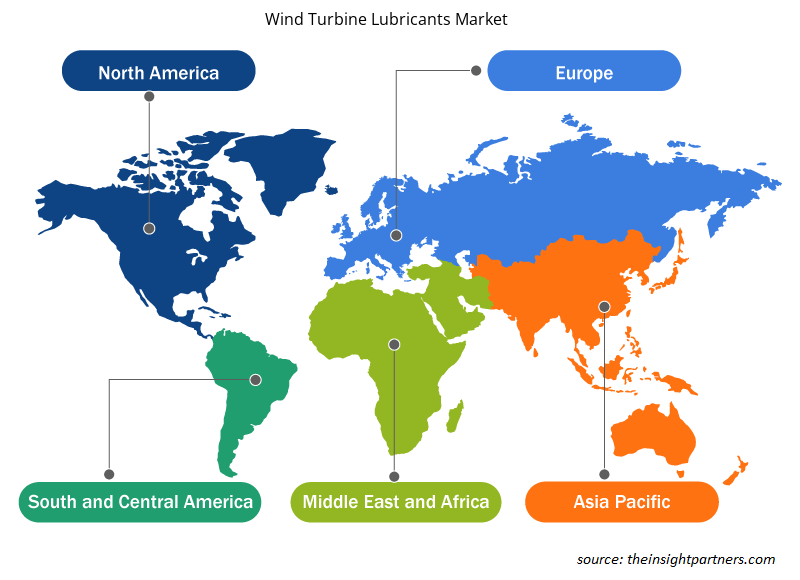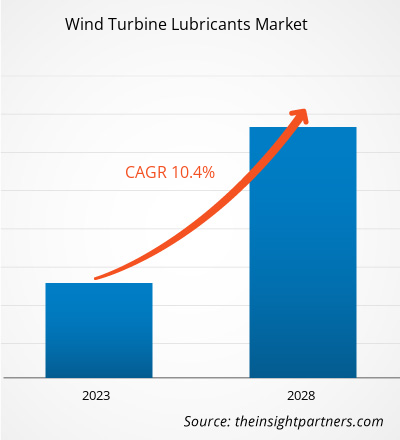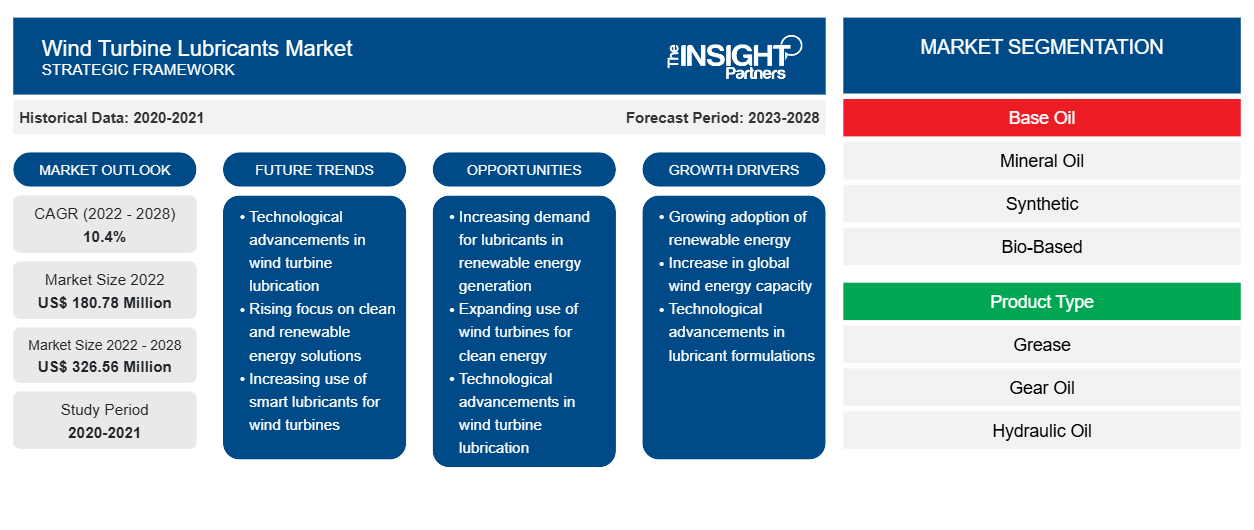[Rapporto di ricerca] Si prevede che il mercato dei lubrificanti per turbine eoliche crescerà da 180,78 milioni di dollari nel 2022 a 326,56 milioni di dollari entro il 2028; si stima che registrerà un CAGR del 10,4% dal 2022 al 2028.
I lubrificanti per turbine eoliche svolgono un ruolo importante nel funzionamento, nella manutenzione e nell'affidabilità delle attrezzature nei parchi eolici. Le turbine eoliche hanno vari punti di lubrificazione come riduttore, riduttore aperto, riduttore di passo, cuscinetto di passo, cuscinetto di imbardata, sistemi idraulici e cuscinetti del generatore. I diversi lubrificanti utilizzati nelle turbine eoliche sono oli per ingranaggi, oli idraulici e grassi. L'olio per ingranaggi è utilizzato per la lubrificazione dei riduttori. Nelle turbine eoliche, il grasso è utilizzato sul cuscinetto dell'albero del rotore principale, sul cuscinetto di imbardata, sugli ingranaggi di trasmissione del passo, sul cuscinetto delle pale e sul cuscinetto del generatore.
La quota di mercato globale dei lubrificanti per turbine eoliche per l'Asia Pacifico è stata la più grande nel 2022. Il mercato dei lubrificanti per turbine eoliche nell'Asia Pacifico è segmentato in Australia, Cina, India, Giappone, Corea del Sud e resto dell'Asia Pacifico. La Cina è un importante contributore alla crescita del mercato in questa regione. Il paese è stato il produttore di energia rinnovabile più grande e in più rapida crescita al mondo per oltre un decennio. Inoltre, ha il più grande mercato di energia eolica al mondo. La Cina è rimasta il più grande mercato al mondo per le nuove aggiunte onshore nel 2020, guidata dal taglio della tariffa feed-in (FiT). Anche l'India ha registrato una notevole crescita del settore dell'energia eolica grazie a varie politiche e normative favorevoli adottate dai governi nazionali e statali. Inoltre, paesi come Taiwan, Corea del Sud, Vietnam e Filippine stanno anche adottando varie iniziative per aumentare le loro capacità eoliche installate, aggiungendosi alla domanda di lubrificanti per turbine eoliche della regione.
Personalizza questo report in base alle tue esigenze
Riceverai la personalizzazione gratuita di qualsiasi report, comprese parti di questo report, o analisi a livello nazionale, pacchetto dati Excel, oltre a usufruire di grandi offerte e sconti per start-up e università
-
Scopri le principali tendenze di mercato in questo rapporto.Questo campione GRATUITO includerà analisi di dati che spaziano dalle tendenze di mercato alle stime e alle previsioni.
Impatto della pandemia di COVID-19 sul mercato dei lubrificanti per turbine eoliche
Il sostegno governativo alle energie rinnovabili e l'aumento delle installazioni di turbine eoliche hanno contribuito in modo significativo alla crescita del mercato dei lubrificanti per turbine eoliche. Tuttavia, nel 2020, vari settori hanno dovuto rallentare le proprie attività a causa delle interruzioni nella catena del valore causate dalle restrizioni sui confini nazionali e internazionali. Ciò ha portato alla chiusura degli impianti di produzione, che ha avuto un impatto negativo sulla crescita del mercato dei lubrificanti per turbine eoliche all'inizio del 2020. Il calo delle installazioni eoliche all'inizio del 2020 ha ostacolato la domanda di lubrificanti per turbine eoliche.
Tuttavia, il settore dell'energia eolica si è ripreso con vigore nella seconda metà dell'anno, quando i mercati eolici maturi ed emergenti hanno iniziato a superare gli impatti della pandemia. Inoltre, il mercato globale ha iniziato a riprendersi dalle perdite subite in precedenza durante la pandemia, quando i governi di diversi paesi hanno annunciato allentamenti nelle restrizioni sociali. Inoltre, i crescenti tassi di vaccinazione hanno creato ambienti favorevoli al progresso industriale. Secondo il Global Wind Energy Council, l'industria eolica globale ha assistito a una crescita record anno su anno (YoY) del 53% nel 2020. L' industria ha installato oltre 93 GW di energia eolica durante il picco della pandemia di COVID-19, nonostante le interruzioni nella catena di fornitura globale e nella costruzione del progetto . Un aumento della capacità installata eolica ha comportato una maggiore domanda di lubrificanti per turbine eoliche, poiché i lubrificanti vengono utilizzati per lubrificare diverse parti delle turbine eoliche.
Approfondimenti di mercato
L'aumento della capacità eolica installata rafforza la domanda di lubrificanti per turbine eoliche
L'energia eolica aiuta a ridurre la dipendenza dai combustibili fossili, il che si traduce in un crescente interesse per questa risorsa rinnovabile in diversi paesi. Secondo il "Global Wind Report 2021" pubblicato dal Global Wind Energy Council, nel 2020, le nuove installazioni di energia eolica hanno superato i 90 GW, ovvero il 53% in più rispetto alla capacità aggiunta nel 2019. Ciò ha portato a una capacità installata totale di 743 GW nel mondo, registrando un aumento del 14% rispetto al 2019. Nel 2020, le nuove installazioni nei parchi eolici onshore hanno raggiunto 86,9 GW, mentre i parchi eolici offshore hanno raggiunto 6,1 GW, rendendo il 2020 rispettivamente l'anno più alto e il secondo più alto nella storia per le nuove installazioni eoliche onshore e offshore. Varie parti della turbina eolica devono essere lubrificate utilizzando grassi, oli per ingranaggi, oli idraulici e altri lubrificanti. Pertanto, la crescente capacità eolica installata a livello globale sta guidando la crescita del mercato dei lubrificanti per turbine eoliche.
Approfondimenti sugli oli base
In base all'olio base, il mercato globale dei lubrificanti per turbine eoliche è segmentato in olio minerale, sintetico e di origine biologica. Il segmento sintetico ha detenuto la quota di mercato più grande dei lubrificanti per turbine eoliche nel 2022. I lubrificanti sintetici sono realizzati con componenti di olio che sono stati prodotti sinteticamente attraverso la reazione di alcuni composti chimici ben definiti, che sono spesso a base di petrolio piuttosto che raffinati da greggi petroliferi esistenti o oli vegetali. I lubrificanti sintetici sono i lubrificanti più comunemente utilizzati nel settore delle turbine eoliche poiché gli oli sintetici hanno un punto di scorrimento inferiore, che consente al cambio di funzionare in modo efficiente a temperature più basse.
I principali attori che operano nel mercato globale dei lubrificanti per turbine eoliche includono TotalEnergies, Exxon Mobil Corporation, FUCHS, BP plc, Klüber Lubrication, Shell, Phillips 66 Company, Chevron, Afton Chemical, AMSOIL INC. e The Lubrizol Corporation. Gli attori del mercato globale si concentrano sulla fornitura di prodotti di alta qualità per soddisfare la domanda dei clienti. Per questo, investono in modo significativo in attività di ricerca e sviluppo.
Segnala i riflettori
- Tendenze industriali progressive nel mercato dei lubrificanti per turbine eoliche per aiutare gli operatori a sviluppare strategie efficaci a lungo termine
- Strategie di crescita aziendale adottate dai mercati sviluppati e in via di sviluppo
- Analisi quantitativa del mercato dei lubrificanti per turbine eoliche dal 2020 al 2028
- Stima della domanda globale di lubrificanti per turbine eoliche
- Analisi delle cinque forze di Porter per illustrare l'efficacia degli acquirenti e dei fornitori che operano nel settore
- Sviluppi recenti per comprendere lo scenario competitivo del mercato
- Tendenze e prospettive di mercato, nonché fattori che guidano e frenano la crescita del mercato dei lubrificanti per turbine eoliche
- Assistenza nel processo decisionale evidenziando le strategie di mercato che sostengono l'interesse commerciale, portando alla crescita del mercato
- Le dimensioni del mercato dei lubrificanti per turbine eoliche in vari nodi
- Panoramica dettagliata e segmentazione del mercato, nonché dinamiche del settore dei lubrificanti per turbine eoliche
- Le dimensioni del mercato dei lubrificanti per turbine eoliche in varie regioni con promettenti opportunità di crescita
Approfondimenti regionali sul mercato dei lubrificanti per turbine eoliche
Le tendenze regionali e i fattori che influenzano il mercato dei lubrificanti per turbine eoliche durante il periodo di previsione sono stati ampiamente spiegati dagli analisti di Insight Partners. Questa sezione discute anche i segmenti e la geografia del mercato dei lubrificanti per turbine eoliche in Nord America, Europa, Asia Pacifico, Medio Oriente e Africa e America meridionale e centrale.

- Ottieni i dati specifici regionali per il mercato dei lubrificanti per turbine eoliche
Ambito del rapporto di mercato sui lubrificanti per turbine eoliche
| Attributo del report | Dettagli |
|---|---|
| Dimensioni del mercato nel 2022 | 180,78 milioni di dollari USA |
| Dimensioni del mercato entro il 2028 | 326,56 milioni di dollari USA |
| CAGR globale (2022 - 2028) | 10,4% |
| Dati storici | 2020-2021 |
| Periodo di previsione | 2023-2028 |
| Segmenti coperti |
Per olio base
|
| Regioni e Paesi coperti |
America del Nord
|
| Leader di mercato e profili aziendali chiave |
|
Densità degli attori del mercato dei lubrificanti per turbine eoliche: comprendere il suo impatto sulle dinamiche aziendali
Il mercato dei lubrificanti per turbine eoliche sta crescendo rapidamente, spinto dalla crescente domanda degli utenti finali dovuta a fattori quali l'evoluzione delle preferenze dei consumatori, i progressi tecnologici e una maggiore consapevolezza dei vantaggi del prodotto. Con l'aumento della domanda, le aziende stanno ampliando le loro offerte, innovando per soddisfare le esigenze dei consumatori e capitalizzando sulle tendenze emergenti, il che alimenta ulteriormente la crescita del mercato.
La densità degli operatori di mercato si riferisce alla distribuzione di aziende o società che operano in un particolare mercato o settore. Indica quanti concorrenti (operatori di mercato) sono presenti in un dato spazio di mercato in relazione alle sue dimensioni o al valore di mercato totale.
Le principali aziende che operano nel mercato dei lubrificanti per turbine eoliche sono:
- Totale Energie SE
- Società anonima BP
- Gallone
- ExxonMobil Corporation
- FUCHS Petrolub SE
Disclaimer : le aziende elencate sopra non sono classificate secondo un ordine particolare.

- Ottieni una panoramica dei principali attori del mercato dei lubrificanti per turbine eoliche
Mercato dei lubrificanti per turbine eoliche
In base all'olio base, il mercato dei lubrificanti per turbine eoliche è segmentato in olio minerale, sintetico e di origine biologica. Il mercato globale dei lubrificanti per turbine eoliche è segmentato in base al tipo di prodotto in grasso, olio per ingranaggi, olio idraulico e altri.
Profili aziendali
- Totale Energie SE
- Società anonima BP
- Gallone
- ExxonMobil Corporation
- FUCHS Petrolub SE
- Klüber Lubrication GmbH & Co.
- Azienda Phillips 66
- Società per azioni Shell
- La società Lubrizol
- Prodotti chimici Afton
- SOCIETÀ AMMINISTRATIVA AMSOIL INC.
- Analisi storica (2 anni), anno base, previsione (7 anni) con CAGR
- Analisi PEST e SWOT
- Valore/volume delle dimensioni del mercato - Globale, Regionale, Nazionale
- Industria e panorama competitivo
- Set di dati Excel
Report recenti
Rapporti correlati
Testimonianze
Motivo dell'acquisto
- Processo decisionale informato
- Comprensione delle dinamiche di mercato
- Analisi competitiva
- Analisi dei clienti
- Previsioni di mercato
- Mitigazione del rischio
- Pianificazione strategica
- Giustificazione degli investimenti
- Identificazione dei mercati emergenti
- Miglioramento delle strategie di marketing
- Aumento dell'efficienza operativa
- Allineamento alle tendenze normative























 Ottieni un campione gratuito per - Mercato dei lubrificanti per turbine eoliche
Ottieni un campione gratuito per - Mercato dei lubrificanti per turbine eoliche